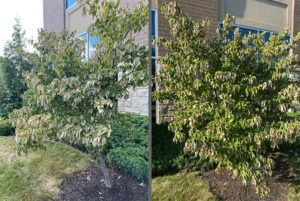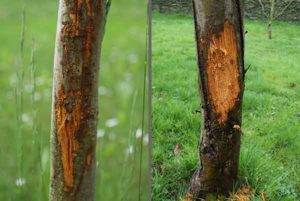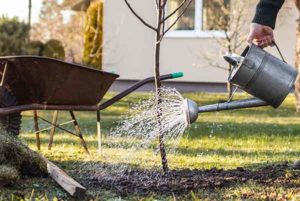Winter Drought Stress in Trees and Why They Need Water
Homeowners often expect a lawn care reprieve when temperatures drop in the fall and plant life goes dormant for the Winter. After a Summer spent watering, cutting grass and keeping up with fertilizer applications, it’s nice to have weekends free of outside chores for a few months.
However, the weather outside may be frightful, and there may be snow on the ground or forecasted, but we’re here to tell you that you aren’t off the hook entirely! Even though we think trees don’t need water until Spring, they need water all Winter.
So pull out your hat and gloves. It’s time to step outside and take care of your trees!
Why Do Trees Need Water During the Winter?
We’ve been taught that when temperatures drop in the Fall, outside plants and trees go dormant until it warms in the Spring. We see this as the leaves drop in the case of herbaceous plants and deciduous trees.
However, tree roots don’t go dormant. Through the Winter, they continue growing and creating a solid foundation for the tree.

Evergreens also continue to photosynthesize and transpire through the winter, so they need a constant water supply. They use less water because photosynthesis rates are lower and lose less water during transpiration because temperatures are cooler, but water use and loss still occur. Cold, dry air and winter winds increase the rate at which water is lost, similar to hot, dry, windy Summer conditions.
As evaporation and photosynthesis occur, water is pulled from the roots to the leaves, creating an imbalance in the roots. It creates drought stress if we aren’t regularly irrigating as we do in the warmer months.
This drought stress results in root damage and, if severe enough, death. When the roots die, the cycle worsens since water uptake is further hindered.
Beyond direct damage, a weakened root system increases a tree’s susceptibility to root rots, cankers, wood rots, and sensitivity to environmental and abiotic stressors.
Moist soil also holds more heat, which helps insulate tree roots better than dry winter soil, and supports beneficial soil microbes and nutrient uptake into the roots, both of which are vital to long-term tree health and soil fertility.
Do Only Young Trees Need Water?
All trees, whether deciduous or evergreen, young or mature, need water all year to stay alive.
Yes, young trees typically need more water than established mature trees. They have small root balls that don’t expand far into the surrounding soil. Their limited root system can only take in so much water and nutrients to fuel growth, so they need consistently moist soil. This smaller root system is why young or newly-planted trees feel the effects of drought stress much quicker, especially Winter drought stress.
Mature, established trees have extensive root systems that reach into the surrounding soil areas, allowing them to access more soil moisture. Therefore, they are less affected by dry Winter soil and frigid, dry Winter winds. It doesn’t mean you can ignore them when it’s cold, though—they are still susceptible to Winter drought stress.
What Does Winter Drought Stress Look Like in Trees?

Since deciduous trees have dropped their leaves, it’s impossible to see drought stress as it occurs. The damage becomes apparent in Spring when they break dormancy and start actively growing. You’ll often see smaller leaves, thin canopies, and maybe even terminal branches die back.
Winter drought stress symptoms appear in evergreens as desiccated winter foliage. You’ll see brown leaf tips and margins and even dead leaves. Twigs and terminal branches may also die back, so the whole tree looks scorched or diseased.
Extreme Winter drought combined with long periods of below-freezing temperatures and drying winds can severely damage or kill even the hardiest tree species.
Doesn’t Snow Provide Enough Moisture?

- On average, an inch of water produces about 10” of snow. In reverse, 5” of snow does not equate to 5” of irrigation water—it produces 0.5”. If the snow is heavy and wet, it can provide slightly more water (4 to 5” of snow make an inch of water) but yield less if the snow is dry and powdery.
- Any water in the snow isn’t available to the tree’s roots until temperatures get warm enough that it melts.
- Below-freezing temperatures freeze the soil, too, making it so water cannot penetrate the surface and reach the roots.
How Can I Tell If My Trees Need Water?
During Winter, you can’t rely on droopy or wilted foliage (or other visual cues) to determine if your tree is water-stressed. To ensure the soil stays appropriately moist, you’ll have to manually check if there’s enough water in the root zone.
When temperatures are above freezing and the soil thaws:
- Dig a hole 12” deep to check the soil moisture. Dig away from the tree’s base to avoid damaging the roots.
- Invest in a high-quality soil moisture meter—take a moisture reading at least 12” below the surface.
Regardless of your method, if you find the soil is dry, it’s time to irrigate. Mature trees typically need irrigation at least once a month; young trees need water every two to three weeks. You may need to water more frequently during cold, dry, windy weather.
Like in the summer, bigger plants have more roots and need more water, more often during the winter.
Can I Run My Irrigation System?
People that live in temperature regions—e.g., where temperatures stay above freezing—can run their irrigation systems through the winter to water their trees when necessary. If you live in a cold climate, you likely drain your irrigation system for the Winter to keep underground lines from freezing and bursting. If that’s the case, you should water with a garden hose or use a perforated bucket.
How to Water Trees When It’s Cold
Similar to watering in the Summer, supplemental watering during the winter months should also be “low and slow” to let the moisture soak into the soil and reach the roots. Watering this way encourages the water to flow into the ground slowly, moving down through the root system to the appropriate soil depth.

The tricky part is timing. You have to wait for a clear (preferably sunny) day where temperatures are at least 40°F and there’s no snow covering the ground around the tree. You need the soil to thaw and the water to soak into the ground.
Use the tree’s rough trunk diameter to determine the volume of water your tree needs. The general rule of thumb is to supply 10 gallons for each inch of tree diameter measured approximately 6 inches above ground level. For instance, a six-inch diameter tree needs 60 gallons at each watering.
The first few times you water, you’ll need to monitor your hose’s flow rate to gauge output. For smaller trees, you can use 5-gallon buckets perforated with smaller holes at the bottom. Fill the bucket with water and set it within the tree’s drip line, allowing the water to trickle out and soak into the soil slowly.
When watering during the Winter, it’s ideal to start as early as possible in the day to give the moisture time to reach the root zone before temperatures drop again in the late afternoon or early evening.
Other Ways to Reduce Winter Dehydration
Beyond watering your trees at least once a month, there are other ways to minimize winter dehydration.
Keep Your Trees Well-Irrigated Through the Summer and Fall
A strong, healthy tree is better prepared to handle water stress any time of the year, winter included. To keep your tree healthy, make sure to regularly water it during the hot Summer weather, continuing until cold weather approaches and dormancy begins.
It’s similar to topping off your gas tank—water in the tree will be at an optimum level, and hydrated plant tissue and soil are better able to withstand severe weather.
Improve Your Soil’s Water-Holding Capacity
Before planting new trees, add plenty of finished compost to the planting hole to increase nutrient levels and improve the soil’s water-holding ability. Water molecules bind to the soil’s organic matter particles, so more water is available year-round to the roots. Moist soil also holds heat better, insulating the roots.
Over time you can also work compost into the top layer of soil around the base of the tree.
Further Insulate the Soil with Mulch
Another great way to help the soil hold more heat is by adding a thick layer of mulch around the tree’s base. Mulch helps slow water evaporation from the ground and regulates the soil temperature, keeping the roots from experiencing drastic temperature swings. The mulch will slowly break down over time, enriching the soil as well.
When you spread mulch, keep it a couple of inches away from the base of the trunk. Any absorbent material touching the trunk flare is a prime place for bacteria and fungus to grow, increasing the chances you’ll see disease problems in your tree.
Professional Winter Tree Care
If winter watering is overwhelming or confusing, let the Ryan Lawn & Tree professionals help! Our trained service experts can further explain the problems associated with winter drought stress and help you create a healthy tree care program. Contact us today for a Free Estimate and let us help you with winter tree care needs by a RYAN tree care expert!









